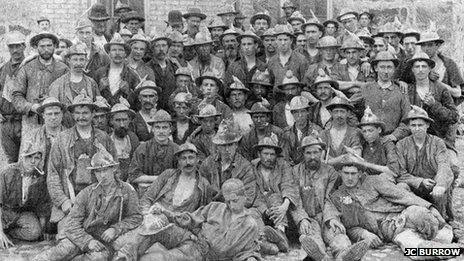Pasties and miners bring Mexican minister to Cornwall
- Published

When tin mining declined in Cornwall thousands went abroad to find work
Gastronomes may associate tortillas, enchiladas and refried beans with Mexican food, but would they raise an eyebrow if the Cornish pasty was added to the list?
Quite possibly, yet the humble dish, known locally as the "paste", is so popular Mexico hosts an annual pasty festival and has even opened a pasty museum.
And to further strengthen the bond between county and country, one of Mexico's tourism ministers is currently visiting Cornwall.
The link dates back to the early 19th Century when Cornwall's tin mining industry fell into decline, forcing thousands of miners abroad to search for work.
'Wonderful names'
Hundreds of men chose to cross the ocean to Mexico to mine silver.
Now Juan Renato Olivares, tourism minister for the Mexican region of Hidalgo, is hoping to encourage more Cornish people to visit his country.
"The Mexicans are immensely proud of their extraordinary links with Cornwall as so many of the descendents of the original miners live in Mexico - people with wonderful names such as Enrique Pengelly and Raoul Pascoe," he said, speaking through interpreter Bridget Galsworthy Estavillo.
Mrs Galsworthy Estavillo, who was born in Cornwall but now lives in Mexico, said when the Cornish miners arrived in Central America, they brought "state-of-the-art" knowledge to the derelict silver mines.
"They were the Silicon Valley of the time in terms of mining technology," she said.
Some miners later returned to Cornwall, but those who did not were buried in the Cornish Cemetery in Real del Monte, which until recent years had fallen into disrepair.
Mrs Galsworthy Estavillo has been involved in the restoration of the cemetery for the past few years and Mr Olivares is hoping that by applying for membership with the Cornish Mining Attractions Marketing Association, the Cornish Cemetery in Mexico could eventually become affiliated with Cornwall's World Heritage Site.
"The cemetery on the top of the hill is one of the most beautiful and poignant places you could ever find," Mrs Galsworthy Estavillo said.
"All the graves lie in one direction because the miners all asked to be buried pointing back to Cornwall.
"It is very dear to my heart and through the inscriptions on the tombstones, I feel I know many of the miners... no-one who visits it walks away unmoved."
There has been a "sudden and revived interest" in the extraordinary history of the Cornish miners in Mexico, which the tourism authorities want to use to form stronger cultural and tourist links between Cornwall and Hidalgo.
'Local delicacy'
Part of Cornwall mining's bid for World Heritage status included an "outreach" to cover foreign sites where Cornish miners migrated to the 19th Century, so Mr Olivares hopes the links between Real del Monte will mean Mexico's affiliation application will be accepted.
Mrs Galsworthy Estavillo said another strong link between the two areas is the Cornish pasty - or paste as it is known there.
As well as their mining know-how, the miners also took their Cornish pasty-making skills.
The pasty is said to have been favoured by the miners because it was filling, easy to carry and the crimp could be held with dirty fingers and then thrown away.
In Mexico, the traditional recipe of beef, potatoes, onions and turnip may have been "tweaked" to include alternative fillings, including peppers and hot chilli sauce.
While similar to the empanadas found across the Americas, the pastes of Hidalgo are famous in Mexico and considered a local delicacy.
So much so, the pasties have attracted thousands of tourists to Real Del Monte for the three-day international pasty festival which has been held in the town annually since 2009.